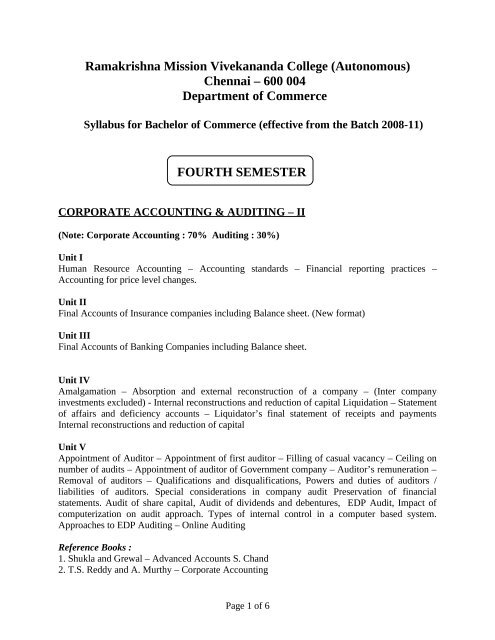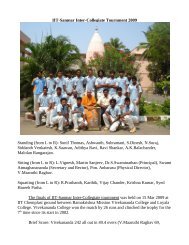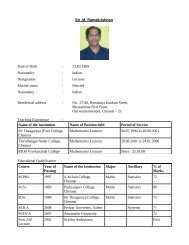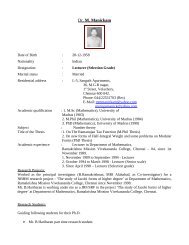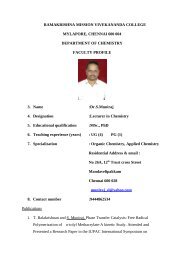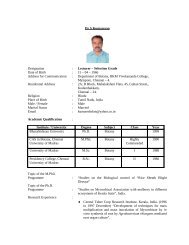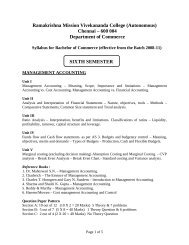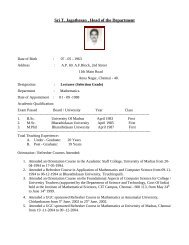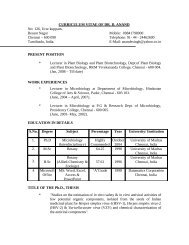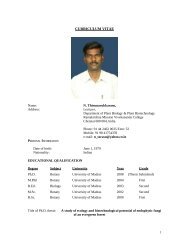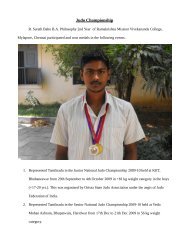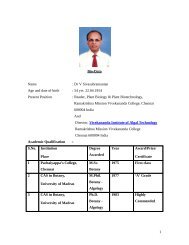Ramakrishna Mission Vivekananda College (Autonomous) Chennai ...
Ramakrishna Mission Vivekananda College (Autonomous) Chennai ...
Ramakrishna Mission Vivekananda College (Autonomous) Chennai ...
You also want an ePaper? Increase the reach of your titles
YUMPU automatically turns print PDFs into web optimized ePapers that Google loves.
<strong>Ramakrishna</strong> <strong>Mission</strong> <strong>Vivekananda</strong> <strong>College</strong> (<strong>Autonomous</strong>)<strong>Chennai</strong> – 600 004Department of CommerceSyllabus for Bachelor of Commerce (effective from the Batch 2008-11)FOURTH SEMESTERCORPORATE ACCOUNTING & AUDITING – II(Note: Corporate Accounting : 70% Auditing : 30%)Unit IHuman Resource Accounting – Accounting standards – Financial reporting practices –Accounting for price level changes.Unit IIFinal Accounts of Insurance companies including Balance sheet. (New format)Unit IIIFinal Accounts of Banking Companies including Balance sheet.Unit IVAmalgamation – Absorption and external reconstruction of a company – (Inter companyinvestments excluded) - Internal reconstructions and reduction of capital Liquidation – Statementof affairs and deficiency accounts – Liquidator’s final statement of receipts and paymentsInternal reconstructions and reduction of capitalUnit VAppointment of Auditor – Appointment of first auditor – Filling of casual vacancy – Ceiling onnumber of audits – Appointment of auditor of Government company – Auditor’s remuneration –Removal of auditors – Qualifications and disqualifications, Powers and duties of auditors /liabilities of auditors. Special considerations in company audit Preservation of financialstatements. Audit of share capital, Audit of dividends and debentures, EDP Audit, Impact ofcomputerization on audit approach. Types of internal control in a computer based system.Approaches to EDP Auditing – Online AuditingReference Books :1. Shukla and Grewal – Advanced Accounts S. Chand2. T.S. Reddy and A. Murthy – Corporate AccountingPage 1 of 6
3. Jain and Narang – Company Accounts4. R.L. Gupta – Corporate Accounting5. Chakraborthi – Advanced Account6. Mukherji and Hanif – Modern Accounts, Vol. I and Vol. II, Tata Mcgraw HillQuestion Paper Pattern:Note :Corporate Accounting & Auditing should have separate subdivisions in all the threesections viz., Section A, B & CSection A:8 out of 9 ( 8*2 =16 Marks) from Corporate Accounting2 out of 3 (2*2= 4 Marks) from AuditingSection B:4 out of 5 (4*8=32 Marks) from Corporate Accounting1 out of 2 (1*8 = 8 Marks) from AuditingSection C:1 out of 2 (1*20= 20 Marks) from Corporate Accounting1 out of 2 (1*20= 20 Marks) from AuditingCOMPANY LAWUnit IDefinition of Joint Stock Company – Kinds – Formation – Incorporation.Unit IIMemorandum of Association – Contents and Alteration – Doctrine of Ultra Vires – Articles ofAssociation – Contents – Distinction between the Two – Doctrine of Indoor Management –Prospectus – Contents – Statement in lieu of Prospectus.Unit IIIShare Capital – Kinds of Shares – Voting Rights – Borrowing powers of companies –Membership in a company – Directors – Legal position – Appointment, Removal, Rights, Dutiesand Powers – Qualification and Disqualifications.Unit IVMeetings and Resolutions – Statutory Meeting – Annual General Meeting – Extra-ordinaryGeneral Meeting – Resolutions – Ordinary and Special Resolutions.Unit VWinding up of a company – Modes of winding up – Winding up by the court – Voluntarywinding up – Member’s voluntary winding up – Creditor’s voluntary winding up.Page 2 of 6
Reference Books :1. Business Laws – N.D. Kapoor, Sultan Chand and Sons2. Business Laws – M.R. Sreenivasan, Margam Publications3. Business Laws – M.V. Dhandapani, Sultan Chand and Sons4. Company Law – Avtar Singh.5. Company Law – N.D. Kappor.6. M.C. Shukla and S.S. Gulshan – Principles of Company Law7. S.M. Shah – Lectures on Company Law8. S. Badri Alam and Saravanavel, Company Law, Himalaya Publications.9. P.P.S. Gogna – Text Book of Company Law – S. ChandQuestion Paper Pattern:Section A : 10 out of 12 (10 X 2 = 20 Marks)Section B : 5 out of 7 (5 X 8 = 40 Marks)Section C : 2 out of 4 (2 X 20 = 40 Marks)INTRODUCTION TO COMPUTERIZED ACCOUNTING & APPLICATIONSNote: Theory : 60% Practical : 40%Unit-IIntroduction to computerized accounting concepts – Basic concepts: accounts, debits, credit,transactions, assets and liabilities- Types of accounts and rules of Generalizing - Journal andledger- Types of balance - Trial balance and final AccountUnit IIE-Commerce - Concepts of E-Commerce, Types of E-Commerce, Areas OD E-Commerce,Type of Transactions in Web, Requirements for E-Commerce, Presenting an Organization inWeb- e-filing of IT-returns.Unit IIIIntroduction to Tally - Introduction to software accounting. Computer Application throughAccounting Package Tally - (Latest Version) – Preparation of following records on Tally (withinventory) – (A) Creation of company, Group, Ledger Accounts, Feeding of Accounting data –Receipts, Payments, Purchase, Sale, Contra, Journal, Credit Note and Debit Note. (B) InventoryInformation – Groups, Items and Valuation. – (C) Generation of various Accounting Reports -Creating accounts - Feeding opening balances - Chart of accounts - Capital– Current assets –Current liabilities – Investments – Loans – Miscellaneous– Sales– Purchase– Direct / Indirectincome / expensesUnit IVPurchase and Sales - Purchase / Sales order - Receipt note - Purchase / Sales bills - Debit /Credit note Journal, Voucher , VAT Bills, service tax , FBT applications,Unit VTrial balance and final account - Ledgerwise trial balance-Trading account- Profit and lossaccount -Balance sheet – Outstanding - Practical work and reports relating to recent softwareapplications for banking and insurance (FINACLE, SAP and recent Applications)Page 3 of 6
Note1 :Recent version of licensed copy of “Tally Package” should be purchased by the college.Note2 :1) <strong>College</strong> should make a provision of necessary computers for commerce department to trainthe students in Computer Accounting as prescribed in the syllabus.2) The study tour may be arranged for increasing the awareness of students regarding Corporateand Banking software Accounting. (Including Industrial Visit)Reference Books :1) Peter Norton’s Computer fundamentals , fourth Edition – McGraw Hill2) Computer fundamentals – Ravichandran D.3) Tally Financial Accounting Program – Current Volume – Tally Press4) Tally for Beginners – Tally Press5) Tally9-Slef Study Training Kit – www.swayam-education.com6) Accounting in a Nutt-shell – Janet WalkerQuestion Paper Pattern:Section A : 10 out of 12 (10 X 2 = 20 Marks)Section B : 5 out of 7 (5 X 8 = 40 Marks)Section C : 2 out of 4 (2 X 20 = 40 Marks)ELEMENTS OF INSURANCEUnit IIntroduction to Insurance – Origin, History, Nature of Insurance, Insurance in India, Marketpotential – Emerging Scenario. Principles of Insurance, Utmost good faith, Insurable interest,Material faith, Indemnity, proximate cost.Unit IIInsurance Laws and Regulations. Contract Act, Insurance Act, LIC Act, GIC Act, IRDA Act,Consumer protection Act. Ombudsman. Life Insurance – selection of Risk and Policy conditions.Risk Management and Reinsurance. Selection of Risks – Computation of Premium.Unit IIILife Insurance Products – Team Insurance, Whole Life, Endowment Annuities. InsuranceDocuments – Proposal Forms, Agents Confidential Report, Declaration of good health, MedicalReport, Policy Form etc., Policy conditions and privileges – Age Admission, Revival, Loans,Claims etc.Unit IVIntroduction to general Insurance. Fire, Motor, Marine, Health, Miscellaneous. Group InsuranceSchemes – Group Insurance, Group Gratuity, Superannuation and Pension Plan. Rural Insuranceand Insurance for weaker sections of society.Unit VMarketing of Insurance Products – Selling Processes.Page 4 of 6


